 W
WNesospiza is a genus of seed-eating birds in the tanager family Thraupidae found on the Tristan da Cunha archipelago in the South Atlantic Ocean.
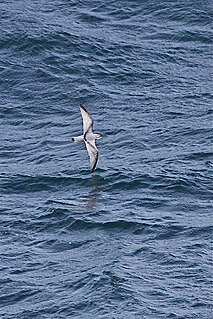 W
WPachyptila is a genus of seabirds in the family Procellariidae and the order Procellariiformes. The members of this genus and the blue petrel form a sub-group called prions. They range throughout the southern hemisphere, often in the much cooler higher latitudes. Three species, the Broad-billed Prion, the Antarctic Prion and the Fairy Prion, range into the subtropics.
 W
WThe Atlantic yellow-nosed albatross is a large seabird in the albatross family. The scientific name is from Ancient Greek. Thalassarche is from thalassa, "sea" and arkhe, "command", and chlororhynchos is from khloros, "yellow", and rhunkhos, "bill".
 W
WThe black-browed albatross, also known as the black-browed mollymawk, is a large seabird of the albatross family Diomedeidae; it is the most widespread and common member of its family.
 W
WThe grey-headed albatross also known as the grey-headed mollymawk, is a large seabird from the albatross family. It has a circumpolar distribution, nesting on isolated islands in the Southern Ocean and feeding at high latitudes, further south than any of the other mollymawks. Its name derives from its ashy-grey head, throat and upper neck.
 W
WThe light-mantled albatross also known as the grey-mantled albatross or the light-mantled sooty albatross, is a small albatross in the genus Phoebetria, which it shares with the sooty albatross. The light-mantled albatross was first described as Phoebetria palpebrata by Johann Reinhold Forster, in 1785, based on a specimen from south of the Cape of Good Hope.
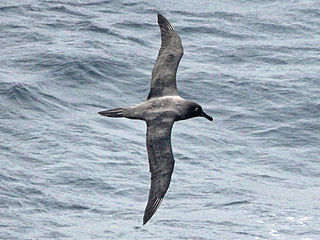 W
WThe sooty albatross, dark-mantled sooty albatross or dark-mantled albatross,, is a species of bird in the albatross family. They breed on sub-Antarctic islands and range at sea across the Southern Ocean from South America to Australia.
 W
WThe Tristan albatross is a large seabird from the albatross family. One of the great albatrosses of the genus Diomedea, it was only widely recognised as a full species in 1998.
 W
WThe wandering albatross, snowy albatross, white-winged albatross or goonie is a large seabird from the family Diomedeidae, which has a circumpolar range in the Southern Ocean. It was the last species of albatross to be described, and was long considered the same species as the Tristan albatross and the Antipodean albatross. A few authors still consider them all subspecies of the same species. The SACC has a proposal on the table to split this species, and BirdLife International has already split it. Together with the Amsterdam albatross, it forms the wandering albatross species complex. The wandering albatross is one of the two largest members of the genus Diomedea, being similar in size to the southern royal albatross. It is one of the largest, best known, and most studied species of bird in the world, with it possessing the greatest known wingspan of any living bird. This is also one of the most far ranging birds. Some individual wandering albatrosses are known to circumnavigate the Southern Ocean three times, covering more than 120,000 km (75,000 mi), in one year.
 W
WThe Indian yellow-nosed albatross is a member of the albatross family, and is the smallest of the mollymawks. In 2004, BirdLife International split this species from the Atlantic yellow-nosed albatross; however Clements has not split it yet, and the SACC has not either, but recognises the need for a proposal.
 W
WThe flying steamer duck, also known as the flying steamer-duck or flying steamerduck, is a species of South American duck in the family Anatidae.
 W
WThe southern fulmar is a seabird of the Southern Hemisphere. Along with the northern fulmar, F. glacialis, it belongs to the fulmar genus Fulmarus in the family Procellariidae, the true petrels. It is also known as the Antarctic fulmar or silver-grey fulmar.
 W
WThe grey petrel, also called the brown petrel, pediunker or grey shearwater is a species of seabird in the Procellariidae, or petrel family. It occurs in the open seas of the Southern Hemisphere, mainly between 49°S and 32°S.
 W
WThe king penguin is the second largest species of penguin, smaller, but somewhat similar in appearance to the emperor penguin. There are two subspecies: A. p. patagonicus and A. p. halli; patagonicus is found in the South Atlantic and halli in the South Indian Ocean and at Macquarie Island.
 W
WThe chinstrap penguin is a species of penguin that inhabits a variety of islands and shores in the Southern Pacific and the Antarctic Oceans. Its name stems from the narrow black band under its head, which makes it appear as if it were wearing a black helmet, making it easy to identify. Other common names include ringed penguin, bearded penguin, and stonecracker penguin, due to its loud, harsh call.
 W
WThe gentoo penguin is a penguin species in the genus Pygoscelis, most closely related to the Adélie penguin and the chinstrap penguin. The earliest scientific description was made in 1781 by Johann Reinhold Forster with a type locality in the Falkland Islands. They call in a variety of ways, but the most frequently heard is a loud trumpeting which the bird emits with its head thrown back.
 W
WThe macaroni penguin is a species of penguin found from the Subantarctic to the Antarctic Peninsula. One of six species of crested penguin, it is very closely related to the royal penguin, and some authorities consider the two to be a single species. It bears a distinctive yellow crest, and the face and upperparts are black and sharply delineated from the white underparts. Adults weigh on average 5.5 kg (12 lb) and are 70 cm (28 in) in length. The male and female are similar in appearance; the male is slightly larger and stronger with a relatively larger bill. Like all penguins, it is flightless, with a streamlined body and wings stiffened and flattened into flippers for a marine lifestyle.
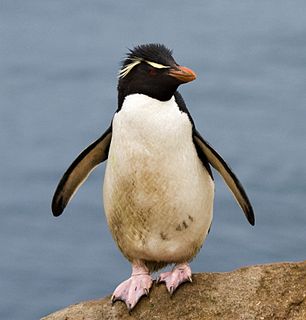 W
WThe southern rockhopper penguin group, are two subspecies of rockhopper penguin, that together are sometimes considered distinct from the northern rockhopper penguin. It occurs in subantarctic waters of the western Pacific and Indian Oceans, as well as around the southern coasts of South America.
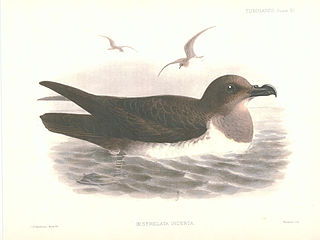 W
WThe Atlantic petrel is a gadfly petrel endemic to the South Atlantic Ocean. It breeds in enormous colonies on Tristan da Cunha and Gough Island, and ranges at sea from Brazil to Namibia, with most records at sea being to the west of the breeding islands, and along the subtropical convergence.
 W
WThe blue petrel is a small seabird in the shearwater and petrel family, Procellariidae. This small petrel is the only member of the genus Halobaena, but is closely allied to the prions. It is distributed across the Southern Ocean but breeds at only six known sites, all close to the Antarctic Convergence zone.
 W
WThe Cape petrel, also called the Cape pigeon, pintado petrel, or Cape fulmar, is a common seabird of the Southern Ocean from the family Procellariidae. It is the only member of the genus Daption, and is allied to the fulmarine petrels, and the giant petrels. They are extremely common seabirds with an estimated population of around 2 million.
 W
WThe Common diving-petrel , also known as the smaller diving-petrel or simply the diving-petrel, is a diving petrel, one of five very similar auk-like small petrels of the southern oceans. It is native to South Atlantic islands and islands of the subantarctic southern Indian Ocean, islands and islets off New Zealand and south-eastern Australian islands.
 W
WThe South Georgia diving petrel or Georgian diving-petrel is one of five very similar small auk-like diving petrels of the southern oceans. It is native to the South Atlantic and islands of the southern Indian Ocean and south-eastern Australia.
 W
WThe northern giant petrel, also known as Hall's giant petrel, is a large predatory seabird of the southern oceans. Its distribution overlaps broadly, but is slightly north of, the similar southern giant petrel.
 W
WThe southern giant petrel, also known as the Antarctic giant petrel, giant fulmar, stinker, and stinkpot, is a large seabird of the southern oceans. Its distribution overlaps broadly with the similar northern giant petrel, though it overall is centered slightly further south. Adults of the two species can be distinguished by the colour of their bill-tip: greenish in the southern and reddish in the northern.
 W
WThe great-winged petrel is a petrel.
 W
WThe Kerguelen petrel is a small slate-grey seabird in the family Procellariidae. The species has been described as a "taxonomic oddball", being placed for a long time in Pterodroma before being split out in 1942 into its own genus Aphrodroma. The position within the procellariids is still a matter of debate; when it was split away from the Pterodroma petrels it was suggested that it may be a fulmarine petrel, whereas a 1998 study placed the species close to the shearwaters and the genus Bulweria.
 W
WThe snow petrel is the only member of the genus Pagodroma. It is one of only three birds that has been seen at the Geographic South Pole, along with the antarctic petrel and the south polar skua, which have the most southerly breeding sites of any bird, inland in Antarctica.
 W
WThe soft-plumaged petrel is a species of seabird in the family Procellariidae.
 W
WThe spectacled petrel is a rare seabird that nests only on the high western plateau of Inaccessible Island in the South Atlantic Tristan da Cunha group. It is one of the largest petrels that nests in burrows.
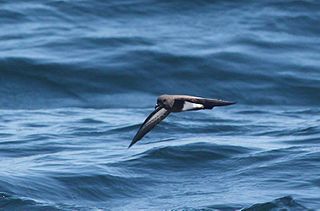 W
WThe black-bellied storm petrel is a species of seabird in the family Oceanitidae.
 W
WThe grey-backed storm petrel is a species of seabird in the austral storm petrel family Oceanitidae. It is monotypic within the genus Garrodia. It is found in Antarctica, Argentina, Australia, Chile, Falkland Islands, French Southern Territories, New Zealand, Saint Helena, South Africa, and South Georgia and the South Sandwich Islands. Its natural habitat is open seas.
 W
WThe white-bellied storm petrel is a species of seabird in the family Oceanitidae. It is found in Angola, Argentina, Australia, Brazil, Chile, Ecuador, French Polynesia, French Southern Territories, Maldives, Namibia, New Zealand, Perú, Saint Helena, and South Africa. Its natural habitat is open seas.
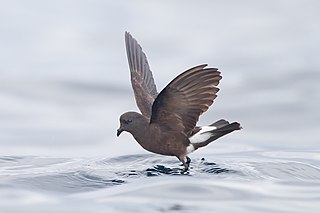 W
WWilson's storm petrel, also known as Wilson's petrel, is a small seabird of the austral storm petrel family Oceanitidae. It is one of the most abundant bird species in the world and has a circumpolar distribution mainly in the seas of the southern hemisphere but extending northwards during the summer of the northern hemisphere. The world population has been estimated to be more than 50 million pairs. The name commemorates the Scottish-American ornithologist Alexander Wilson. The genus name Oceanites refers to the mythical Oceanids, the three thousand daughters of Tethys. The species name is from Latin oceanus, "ocean".
 W
WThe white-chinned petrel or Cape hen, is a large shearwater in the family Procellariidae. It ranges around the Southern Ocean as far north as southern Australia, Peru and Namibia, and breeds colonially on scattered islands.
 W
WThe white-headed petrel, also known as the white-headed fulmar is a species of seabird in the petrel family, or Procellariidae. Its length is about 400 mm.
 W
WEaton's pintail is a dabbling duck of the genus Anas. It is also known as the southern pintail. The species is restricted to the island groups of Kerguelen and Crozet in the southern Indian Ocean. It resembles a small female northern pintail. It was named after the English explorer and naturalist Alfred Edmund Eaton. It is threatened by introduced species, particularly feral cats, which prey on it.
 W
WThe South Georgia pintail, also misleadingly known as the South Georgian teal, is the nominate subspecies of the yellow-billed pintail, a duck in the dabbling duck subfamily Anatinae. It is endemic to the large (3,756 km2) subantarctic island of South Georgia and its accompanying archipelago, and is a vagrant to the South Sandwich Islands. It was among the birds noted by James Cook in January 1775, on the occasion of the first recorded landing on South Georgia, and was formerly considered a full species.
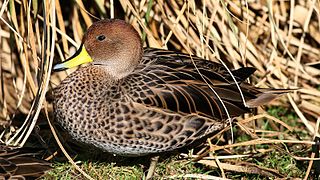 W
WThe yellow-billed pintail is a South American dabbling duck of the genus Anas with three described subspecies.
 W
WThe South Georgia pipit is a sparrow-sized bird only found on the South Georgia archipelago off the Antarctic Peninsula. It is the only song bird in Antarctica, South Georgia's only passerine, and one of the few non-seabirds of the region.
 W
WThe Inaccessible Island rail is a small bird of the rail family, Rallidae. Endemic to Inaccessible Island in the Tristan Archipelago in the isolated south Atlantic, it is the smallest extant flightless bird in the world. The species was described by physician Percy Lowe in 1923 but had first come to the attention of scientists 50 years earlier. The Inaccessible Island rail's affinities and origin were a long-standing mystery; in 2018 its closest relative was identified as the South American dot-winged crake, and it was proposed that both species should be nested within the genus Laterallus.
 W
WThe Kerguelen shag is a species of cormorant endemic to the Kerguelen Islands in the southern Indian Ocean, one of the most isolated places on Earth. Many authorities consider it a subspecies of the imperial shag.
 W
WThe Macquarie shag, Macquarie Island shag or Macquarie Island cormorant, is a marine cormorant native to Macquarie Island in the Southern Ocean, about halfway between Australia and Antarctica.
 W
WThe South Georgia shag, also known as the South Georgia cormorant, is a marine cormorant native to South Georgia and a few other subantarctic islands in the South Atlantic Ocean.
 W
WThe great shearwater is a large shearwater in the seabird family Procellariidae. Ardenna was first used to refer to a seabird by Italian naturalist Ulisse Aldrovandi in 1603, and gravis is Latin for "heavy".
 W
WThe sooty shearwater is a medium-large shearwater in the seabird family Procellariidae. Ardenna was first used to refer to a seabird by Italian naturalist Ulisse Aldrovandi in 1603, and grisea is medieval Latin for "grey".
 W
WThe subantarctic shearwater is a small bird species which breeds in Tristan da Cunha, islands of the southern Indian Ocean and New Zealand Subantarctic Islands.
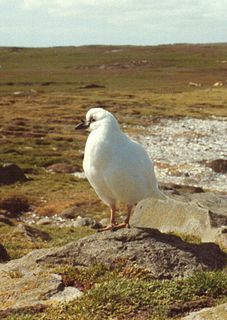 W
WThe black-faced sheathbill, also known as the lesser sheathbill or paddy bird, is one of only two species of sheathbills, aberrant shorebirds which are terrestrial scavengers of subantarctic islands.
 W
WThe snowy sheathbill, also known as the greater sheathbill, pale-faced sheathbill, and paddy, is one of two species of sheathbill. It is usually found on the ground. It is the only land bird native to the Antarctic continent.
 W
WThe brown skua, also known as the Antarctic skua, subantarctic skua, southern great skua, southern skua, or hākoakoa (Māori), is a large seabird that breeds in the subantarctic and Antarctic zones and moves further north when not breeding. Its taxonomy is highly complex and a matter of dispute, with some splitting it into two or three species: Falkland skua, Tristan skua, and subantarctic skua. To further confuse, it hybridizes with both the south polar and Chilean skuas, and the entire group has been considered to be a subspecies of the great skua, a species otherwise restricted to the Northern Hemisphere.
 W
WThe South American snipe or Magellan snipe is a small, stocky wader. Its taxonomic position is complicated, sometimes treated as a race of common snipe. The Andean population is now usually considered a distinct species, known as the puna snipe.
 W
WThe southern rough-winged swallow is a small swallow. It was first formally described as Hirundo ruficollis by French ornithologist Louis Vieillot in 1817 in his Nouveau Dictionnaire d'Histoire Naturelle.
 W
WThe yellow-billed teal is a South American species of duck. Like other teals, it belongs to the diverse genus Anas; more precisely it is one of the "true" teals of subgenus Nettion. It occurs in Argentina, the Falkland Islands, Chile, Peru, Bolivia, Uruguay, and Brazil. It has also established itself in South Georgia, where it was first recorded breeding in 1971, and has been recorded as far east as Tristan da Cunha. It inhabits freshwater wetlands, preferring palustrine habitat to rivers. Considering its wide range and local abundance, it is not considered threatened by the IUCN.
 W
WThe Antarctic tern is a seabird in the family Laridae. It ranges throughout the southern oceans and is found on small islands around Antarctica as well as on the shores of the mainland. Its diet consists primarily of small fish and crustaceans. It is very similar in appearance to the closely related Arctic tern, but it is stockier, and it is in its breeding plumage in the southern summer, when the Arctic tern has shed old feathers to get its non-breeding plumage. The Antarctic tern does not migrate like the Arctic tern does, but it can still be found on a very large range. This tern species is actually more closely related to the South American tern.
 W
WThe Kerguelen tern is a tern of the southern hemisphere.
 W
WThe Sandwich tern is a tern in the family Laridae. It is very closely related to the lesser crested tern, Chinese crested tern, Cabot's tern, and elegant tern and has been known to interbreed with the lesser crested. It breeds in the Palearctic from Europe to the Caspian Sea wintering to South Africa, India and Sri Lanka.
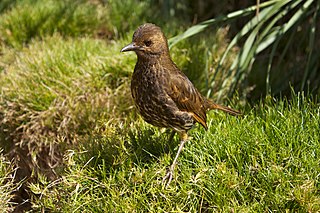 W
WThe Tristan thrush, also known as the starchy, is a species of bird in the thrush family that is endemic to the British overseas territories of the isolated Tristan da Cunha archipelago in the South Atlantic Ocean.